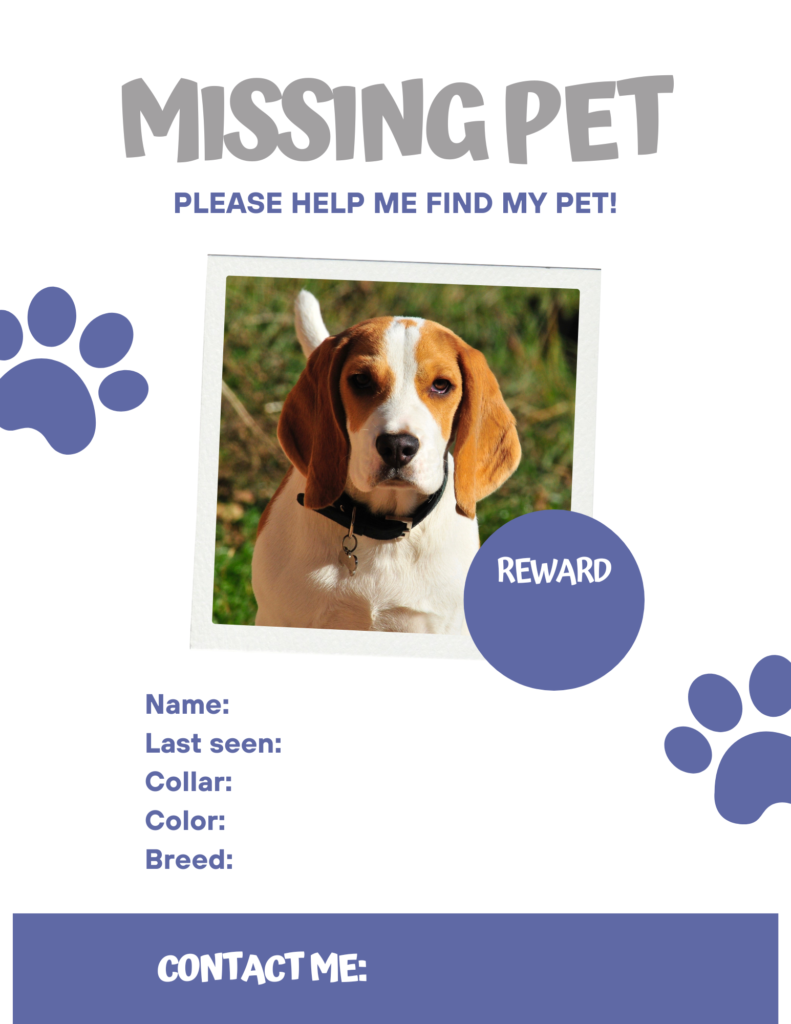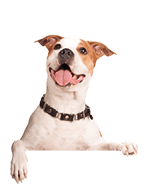*To quickly navigate to a specific emergency and its solution within this blog, simply click on the emergency listed below to learn more:
As a pet sitter and dog walker in Columbus, you’re often the first line of defense in keeping pets safe and healthy. While many days go by smoothly, emergencies can and do happen. Being prepared for both urgent and non-urgent situations is essential.
This guide covers the top 25 emergencies you may face and offers tips on handling each one, plus a general step-by-step approach for managing any emergency situation.
Medical Emergencies
Please note: Many of these emergencies require transporting pets to the vet. For detailed instructions on how to do this successfully and efficiently, refer to the section at the end of this blog.
Allergic Reactions
Severe allergic reactions (commonly from grass, fertilizer, bee stings, foreign foods/treats) can cause swelling or breathing difficulties. Administer antihistamines if recommended by the pet parent and/or vet and get the pet to the vet as quickly as possible.
Broken Bones
Fractures can occur from falls or accidents. Immobilize the affected limb and seek veterinary care promptly.
Choking and/or Difficulty Breathing
Choking and breathing difficulties in pets can be alarming and require immediate action. If you notice your pet gagging, coughing, pawing at their mouth, or showing signs of panic, they may be choking. Try to carefully remove the object if it’s visible and safe to do so. For breathing difficulties, such as wheezing, labored breathing, or blue-tinged gums, it may indicate a serious condition like asthma, heart disease, or an allergic reaction. Keep the pet calm, ensure their airway is clear, and seek veterinary care immediately to address the underlying cause and provide necessary treatment.
Diarrhea
Diarrhea in pets can be a minor issue or a sign of something more serious. Occasional diarrhea may be due to diet changes, stress, or minor gastrointestinal upset. However, persistent or severe diarrhea could indicate infections, parasites, poisoning, or other health problems. It’s important to monitor your pet closely and ensure they stay hydrated. If diarrhea lasts more than a day or comes with other symptoms like vomiting, lethargy, or blood in the stool, seek veterinary care promptly to prevent dehydration and address the underlying cause.
Dog Fights
Dog altercations can occur unexpectedly. Always carry tools like a break stick or citronella spray to separate fighting dogs and know the location of the nearest emergency vet.
Eye Injuries
Severe eye injuries require immediate attention. Avoid touching the injured eye and transport the pet to the vet promptly.
Frostbite
Frostbite in pets occurs when their skin and underlying tissues freeze due to prolonged exposure to cold temperatures. It most commonly affects areas with less fur, like ears, paws, and tails. Early signs of frostbite include pale, cold skin that may feel hard or brittle. As it progresses, the skin can become red, swollen, and painful. Severe frostbite can cause tissue damage, leading to blisters, blackened skin, or even tissue loss. If you suspect frostbite, warm the affected area gradually using warm (not hot) water and seek veterinary care immediately. Prevent frostbite by limiting the pet’s exposure to cold and providing them with proper winter protection like coats or booties. Review our winter dog walking blog for more essential tips!
Heatstroke
Overheating is a common risk in hot weather. Avoid walking pets during peak heat and know the signs of heatstroke to act quickly. Review our summer dog walking blog for more essential tips!
Hit by Car
Pets can be struck by vehicles, leading to serious injuries. Stabilize the pet as much as possible and transport them to the vet immediately. For future, consider keeping pets on a shorter leash during walks (if applicable or hit happened on walk).
Ingesting Toxins
Pets can ingest harmful substances like chocolate, plants, or household chemicals. Likely, it’s foods that pets shouldn’t eat in the first place. Recognizing the symptoms of pet poisoning and having the vet’s number ready can save lives.
Other Health Issues
Pets can suddenly fall ill or get injured. Symptoms like seizures, choking, or severe vomiting require immediate attention. Keep a pet first aid kit and the vet’s contact info handy. Additionally, familiarize yourself with the locations of nearby emergency veterinary clinics.
Severe Bleeding
Pets, especially dogs, can sustain deep cuts or wounds on their paws during walks due to exposure to sharp objects or rough surfaces. Apply pressure to the wound immediately and seek veterinary assistance without delay.
Safety and Security Emergencies
Unable to Access Home
Inability to access a client’s home can happen. Have a backup plan, such as a spare key with a neighbor or a lockbox. If utilizing a lockbox is the only entry method on-site and you’re having trouble with it, here’s some additional tips:
Double-Check Instructions: Always refer to the client’s lockbox instructions BEFORE arriving to a new assignment. Ensure you have the correct code, understand the location and mechanism, and are ready for action.
Check for Obstructions: Ensure there are no obstructions like debris or dirt blocking the lockbox. Know that sometimes using a key of your own for leverage is necessary if the key inside is jammed into the lockbox door. Need to use brute force if you think a key is lodged? Try slamming the lockbox against a hard surface and/or use another key that’s on you to forcefully push down on the “open” lever.
Use Backup Entry Methods: Review client’s notes to see the location of any backup keys or alternative entry methods provided by the client and use if needed.
Communicate with the Team: If you encounter difficulties, contact your team at Hands N Paws immediately for assistance. There might be at least one other person who has encountered the same issue before and can provide the help you’re needing.
Communicate with the Client: If need be, reach out to the client. They may have additional tips or can remotely reset the lockbox somehow.
Locked Out
If you’re locked out of a client’s home, stay calm and check if there’s a spare key in a lockbox or with a trusted neighbor. If not, contact your team immediately to inform them and ask for guidance. Contact the client at that point, too, if necessary. Avoid attempting to force entry, as this could cause damage. In the meantime, ensure the pet is safe and secure in the yard or nearby area, if possible, while you resolve the situation.
Home Alarm Triggered
An alarm system can accidentally be triggered when entering or leaving a client’s home, often due to not following alarm instructions correctly. To avoid this, carefully review alarm notes, especially before arriving at a new assignment. If the alarm does go off, contact the client or security company immediately to prevent a false alarm. Be prepared for a possible visit from the police, and if they arrive, calmly explain who you are and what happened.
Power Outage
If a power outage happens at a client’s home, it could affect climate control or security systems. Inform the client and follow their instructions, especially if the pets rely on powered devices.
Household Hazards
Unexpected hazards like a gas leak, water leak, or electrical issue can pose a serious risk to pets. If you encounter any of these, remove the pet from the danger zone and contact the pet parent and, if necessary, emergency services. Follow the pet parent’s instructions for securing the home and ensuring the pet’s safety.
Suspicious Activity or Unauthorized Visitors
Handling unexpected visitors or workers at a client’s home requires caution. If a location typically has a lot of foot traffic, it’s usually not a concern; however, if new or unfamiliar people appear, verify their identity and inform the pet parent if you believe it’s necessary. It’s important to remain vigilant and report anything unusual.
Escape or Lost Pet
If the pet slips out of their collar or escapes the yard, act immediately. Search the area and call their name calmly but urgently. Use a GPS collar if available to track their location in real-time. Quickly alert neighbors, social media groups, and local shelters, sharing a recent photo and last known location. Time is critical—leave familiar items like toys or bedding outside to help lure them back while you continue your search.

Aggressive Pet Behavior
Encountering aggressive behavior from a pet you’re caring for, or from another animal during a walk, can pose serious safety risks. Stay calm and avoid making direct eye contact, as this can escalate the situation. If possible, create distance by slowly backing away or changing direction, and use any available tools, like treats or a spray deterrent, to manage the aggression. Once the situation is under control, secure the pet and notify the client about the incident, providing details of what happened and any injuries that may have occurred. Your safety and the pet’s well-being should always be the absolute top priority.
Severe Anxiety or Panic
Pets can experience extreme anxiety or panic due to separation, thunderstorms, fireworks, or unfamiliar environments. This can lead to destructive behavior, escape attempts, or self-harm. Calm the pet using soothing tones, and if possible, remove or reduce the anxiety trigger. Contact the team/pet parent for guidance on any anxiety-relief methods they recommend, such as treats, toys, or specific calming techniques.
Logistical Emergencies
Running Out of Supplies
Running out of essential items like food, treats, or medication can be highly stressful, both for the pet and the pet sitter. If this happens, communicate with your team and/or the pet parent immediately so a restocking can be arranged. You may have to run to a local pet supply store or the pet’s vet where you can quickly purchase necessary items. Make sure you are properly reimbursed for any purchases you make!
Schedule Changes
Last-minute cancellations, additions, or changes to your schedule can create significant disruptions, particularly if you’re managing multiple clients. Flexibility is key in handling these situations. To manage unexpected changes, keep a network of backup pet sitters and dog walkers in Columbus, Ohio who can step and help in when needed.
Car Trouble During Visits
Experiencing car trouble on the way to or from a client’s home can delay your visit and potentially leave a pet without timely care. To mitigate this, ensure your vehicle is well-maintained and regularly serviced to reduce the likelihood of breakdowns. If you do encounter car trouble, immediately contact your team to inform them of the delay and see if a reassignment is possible. If the visit can’t be covered, having a backup transportation plan, such as a ride-share service, can be your next best bet in getting to the client’s home quickly. Prepare proactively for any such events in the future.
Overbooked Schedule
As a Columbus pet sitter and dog walker, it’s easy to overbook yourself, which can lead to overwhelm and burnout. Be mindful of your schedule and limit your visits to what your time and emotional capacity can handle. If you’re feeling stretched too thin, reach out to your team for help with visit coverage. Moving forward, it’s crucial to maintain awareness of your boundaries to prevent overcommitment.
A Columbus Pet Sitter’s Generic Guide for Handling Pet Emergencies
1. Recognize the Emergency
- Stay Calm: Take a deep breath and remain calm to help manage the situation effectively.
- Assess the Situation: Quickly determine the nature and severity of the emergency (e.g., injury, choking, illness).
2. Immediate Actions
- Ensure Safety: Move the pet to a safe location away from any immediate danger.
- First Aid: Administer any necessary first aid (e.g., applying pressure to a wound, performing the Heimlich maneuver for choking).
3. Contact Emergency Services
- Call the Vet: Contact the pet’s regular veterinarian or the nearest emergency vet clinic. Provide them with detailed information about the pet’s condition.
- Follow Vet Instructions: Follow any immediate advice or instructions given by the vet.
4. Notify Team Leader
- Contact Team Leader: Inform your team leader or supervisor about the situation as soon as possible. Provide them with details about the emergency and any steps you have taken.
- Follow Protocols: Follow any protocols or procedures your company has in place for handling emergencies.
- Ask for Visit Coverage: If any scheduled assignments are impacted by vet transportation, spending extra time on a current visit due to an emergency, or other related issues, don’t hesitate to ask your team for coverage assistance!
5. Inform the Pet Parent (Client)
Please note: It’s important to prioritize the pet’s health and well-being in the face of life-threatening emergencies, which is why contacting the pet parents comes after reaching out to the vet. Please make sure to act swiftly in getting the pet the care they need, and once the situation is under control, promptly update the pet parents with all relevant details. Their peace of mind is important, but the pet’s immediate safety comes first.
- Call the Pet Parent: Contact the pet parent to inform them of the emergency. Clearly explain the situation, the actions you have taken, and the steps you plan to take next. Ask them for their input as well.
- Provide Updates: Keep the pet parent updated on any developments and follow their instructions if they provide any.
6. Contact Emergency Contacts
- Backup Contacts: If the pet parent cannot be reached, contact the emergency contacts listed in the pet’s care instructions.
- Inform Them: Provide the same detailed information you would give to the pet parent.
7. Transport the Pet (if needed)
- Prepare for Transport: Secure the pet in a carrier or use a leash and harness. For injured pets, ensure they are comfortably and safely positioned.
- Drive Carefully: Transport the pet to the vet as directed, driving carefully to avoid further stress or injury.
8. At the Veterinary Clinic
- Provide Information: Give the vet all necessary information about the pet’s condition and the events leading up to the emergency.
- Follow Up: Stay at the clinic if needed to assist with any further care or to receive updates from the vet.
9. After the Emergency
- Follow Vet Advice: Follow any care instructions provided by the vet for the pet’s recovery.
- Update All Parties: Inform the pet parent, team leader, and any emergency contacts about the outcome and the pet’s current condition.
- Document the Incident: Write a detailed report of the incident, including the time, nature of the emergency, actions taken, and the outcome. This is important for both your records and for informing the pet parent and your team leader. This can be in your post-service communication to the client (phone call, text, email, journal report, etc.).
10. Reflect and Prepare
- Review Procedures: Reflect on the incident and review your actions. Consider any improvements or additional training that could help in future emergencies.
- Restock Supplies: Ensure your first aid kit and any emergency supplies are restocked and ready for future use.
- Follow Up with Pet Parent: Check in with the pet parent a few days later to see how the pet is doing and to offer any further assistance or support.
Tips for Effective Transportation to Columbus Vet Clinics
Transporting an injured or ill pet to a local Columbus vet requires calmness and preparation. Staying calm is crucial as pets can sense your anxiety, which may increase their stress. Always contact the vet ahead of time to inform them of the situation so they can prepare and provide specific advice. Ensure the pet is secure using a carrier, crate, or harness, and handle them gently to avoid aggravating any injuries.
For cats, use a well-ventilated carrier lined with a soft towel or blanket. Covering the carrier with a blanket can help reduce their stress. Secure the carrier in the car to prevent movement. For dogs, use a leash and harness for better control, especially if they are injured or anxious. For large dogs or those with severe injuries, a stretcher or sturdy board can help prevent further injury. Secure the dog in the car using a seatbelt harness or a crate, ensuring they are comfortable and cannot move around excessively.
When handling injuries, apply gentle pressure to any bleeding wounds with a clean cloth or bandage before transport. Immobilize broken limbs using a makeshift splint, avoiding movement of the injured area. For pets with breathing difficulties, ensure their airway is clear and transport them in a position that makes breathing easier, such as on their side or sitting up.
During transport, drive carefully, avoiding sudden stops and sharp turns to prevent further stress or injury. Keep the car at a comfortable temperature and monitor the pet for any signs of distress or worsening condition. To prepare for future emergencies, keep a pet first aid kit and emergency supplies in your car, familiarize yourself with the quickest route to the nearest emergency vet clinic, and consider taking a pet first aid course to be better prepared for handling emergencies.















